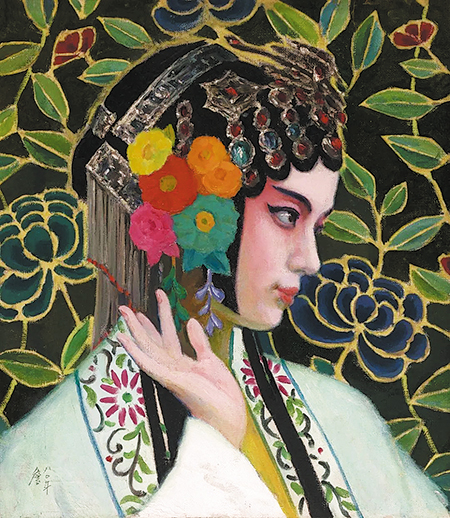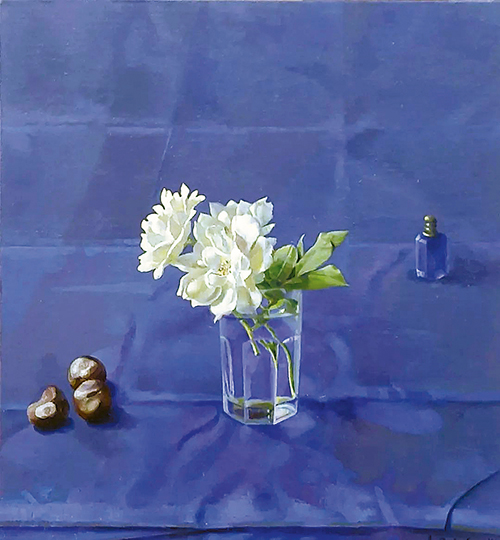Chinese and Spanish artists in the frame

Actress, oil painting by Zhan Jianjun.[Photo provided to China Daily]
Spanish art has produced luminary figures for generations, from Jusepe de Ribera, Diego Velazquez, Francisco Goya in the golden age of oil painting, to Pablo Picasso, Salvador Dali and Joan Miro whose pioneering explorations ushered painting into a new era.
Their talent and creativity keep inspiring artists in China, where the introduction of oil painting over a century ago has enriched the creation of art, especially when it comes to realism, a style which enjoys great popularity here.
In a time when artistic expression is erupting with more diversity, oil artists in China and Spain still experiment with traditional realism to present the many dimensions of life and emotion.
This spirit of perseverance defines Figurative Painting, an oil exhibition of Chinese and Spanish realistic art at the National Center for the Performing Arts in Beijing, which runs through to Jan 12.
The show, also a celebration of the 50th anniversary of the establishment of diplomatic relations between the two nations, brings together over 100 paintings that reflect the evolution of realism over 50 years or so, prompted by oil painters in the two countries.
Chinese artists featured at the exhibition include Jin Shangyi and Quan Shanshi, who both received strict training while continuing to explore the integration of brushwork and color arrangement with Chinese aesthetics, presenting a sense of introversion and subtle beauty.

Flowers, oil painting by Isabel Quintanilla.[Photo provided to China Daily]
Jin says Spanish paintings, especially those from the 17th and 18th centuries, have always been a subject of interest and study for painters in China.
Spanish painters on show include Antonio Lopez Garcia, an artist of prominence and the exhibition's counselor, who said in a video at the exhibition's opening that the show is of great interest, for it introduces to the audience the differences (in society, culture and art) between countries and regions and also the common grounds of understanding.
The exhibition shows how the realistic approach is used to address the different issues in the two countries, with variations in motifs and presentation methods.
"Realism erupts with great vitality in China," says Xu Jiang, one of the artists on show and vice-chairman of the China Artists Association. "On one hand it has been rooted deeply in the soil of Chinese reality and culture, and meanwhile, it has been enriched to be combined with the best of Chinese cultural traditions."
Examples at the exhibition include Trace: No 132, from a series created by Lei Bo, a resident artist of Beijing Fine Art Academy, to show the life of grassroots Chinese.
Grounded in his passion for ancient mural art, Lei has created this series with a similar rough texture and low saturated color that emulates his inspiration. He says that he hopes to present the weight of life's pressures as felt by ordinary people, as well as a sense of inconspicuousness and calmness they feel while going about their business.
Xu says the exhibition shows a much broader sense of realism that has been developed by artists in China and Spain. "While attentive to details, painters also incorporate a semi-imagined, or surrealistic style to share their observations and concerns about the changing mentality of people."
He says that artists in the two countries share a commitment to realism, through which they reveal the sparkling sides of human nature.
Mounted by the China Academy of Art in Hangzhou, Zhejiang province, the exhibition was first held at Quan Shanshi Art Center in November, and is set to travel to Madrid next year.
Related articles
-
 Shanghai exhibition opens celebrating artists from 1900s
Shanghai exhibition opens celebrating artists from 1900sMore
-
 HK gallery opens in Beijing with reflection on the great together
HK gallery opens in Beijing with reflection on the great togetherMore
-
 Colors, texts and poems, the gateways to an artist's world
Colors, texts and poems, the gateways to an artist's worldMore
-
 Why is the design of GPA a good one
Why is the design of GPA a good oneMore
-
 X Museum holds first exhibition at new location
X Museum holds first exhibition at new locationMore
-
 Picture portraits in rural settings
Picture portraits in rural settingsMore
